IMEHA (International Model Equine Hobbyists Association) was an online photo showing site that existing until 2018. Included on the site were these guidebooks for judging and showing model horses in Performance classes. MEPSA has obtained permission to share the info contained in the guides.
Scoring :: Point Deducts :: Tack :: Rider :: Reins :: Set-Up Options :: Photo Examples
Western Pleasure Natural is a class that was written for hobbyists and does not exist in the real world. It is for hobbyists that do not own arena fencing but still want to enter a western pleasure entry. There are no arena fences and most of all No Trail Obstacles in the class. Just envision a western pleasure class but without the arena wall and you have the requirements to enter the class. Attire and tack may be somewhat more relaxed as well. Just as in Western Pleasure Arena the rider is not judged but is important of course for posture, cueing and steering. The class is judged on manners and performance of the horse. The Western pleasure horse regardless of breed performs with a lower head than a natural one, relaxed gaits, slow jog, slow lope and smooth loose or light rein. The head and neck should be carried appropriately for a relaxed performance in accordance to the horse’s breed type and conformation. Horses shall be shown on a reasonable loose rein. Extremes of too tight or too loose should be penalized. While Pleasure Natural is a more relaxed setting than that of the Arena class, the faults of the horse and rider should be scored accordingly:
Wrong lead or break of gait
Stopping rough or crooked
Failure to maintain a pivot foot
Rough transitions
Showing resistance when cued or reined
If rider is used then posting the jog-trot
If rider is used then any stiff, artificial, or unnatural body, leg, arm and/or head position
Poor position of exhibitor in saddle
Rider showing a loose leg with open knee, legs too far forward or back
Riders toes pointed down
Riders shoulders held crooked or arms held in a straight, unbent position
Reins too long, too short, or uneven
For additional helpful hints for Western Pleasure or other disciplines please check out Susan Hargrove’s site at: Oh Joy Farms
You Score Western Pleasure Gaits on the following:
The Walk:
(1) Poor walk – uneven pace and no cadence. Has no flow and may appear intimidated or appear to march.
(2) Average walk – has a four-beat gait, level top-line and is relaxed.
(3) Good walk – has a flowing four-beat gait, level topline, relaxed and is bright and attentive.
The Jog:
(1) Extremely poor jog – cannot perform a two-beat gait and has no flow or balance in the motion.
(2) Very poor jog – hesitates in the motion. Does not keep an even and balanced motion or a level top-line. May appear to shuffle.
(3) Poor jog – average motion but has negative characteristics such as; walking with the hind legs, dragging the rear toes or taking an uneven length of stride with the front and rear legs.
(4) Correct or average jog – has a two-beat gait, a level top-line and a relaxed appearance.
(5) Good jog – has an average motion with positive characteristics such as balance and self-carriage while taking the same length of stride with the front and rear legs.
(6) Very good jog – is comfortable to ride while having a consistent two-beat gait. The horse guides well, appears relaxed and has a level top-line.
(7) Excellent jog – effortless and very efficient motion. Swings the legs yet touches the ground softly. Confident, yet soft with its motion while being balanced and under control. Moves flat with the knee and hock and has some cushion in the pastern. Has a bright and alert expression and exhibits more lift and self-carriage than the “very good jog”.
Moderate Extended Jog:
(1) Poor extended jog – never lengthens the stride and may appear rough to ride.
(2) Average extended jog – moves up in its pace and appears smooth to ride.
(3) Good extended jog – has an obvious lengthening of stride with a slight increase in pace while exerting less effort and appears smooth to ride.
The Lope
(1) Extremely poor lope – does not have a three-beat gait. Has no flow, rhythm or balance. Uncomfortable to ride.
(2) Very poor lope – appears to have a three-beat lope but has no lift or self-carriage. The horse shuffles, has no flow and bobs his head, giving the appearance of exerting a great deal of effort to perform the gait. Also may appear uncomfortable to ride.
(3) Poor lope – has an average motion but exhibits negative characteristics like head bobbing, not completing the stride with the front leg and leaving the outside hock well behind the horse’s buttocks.
(4) Average lope – has a true three-beat gait with a level top-line and very little head and neck motion. He is relatively straight (not over-canted), guides well and has a relaxed appearance.
(5) Good lope – has an average motion but exhibits positive characteristics in his performance like self-carriage, a steady topline, relaxed appearance and is responsive to the rider’s aids.
(6) Very good lope – has more lift and flow than the average horse. He has a strong but smooth drive from behind. He may bend his knee slightly yet still has a level top-line while exhibiting self-carriage with a relaxed appearance. Appears comfortable to ride.
(7) Excellent lope – has a round back with an effortless strong, deep stride with the rear legs and a flat swing with the front legs. He keeps a level top-line, a relaxed yet alert and confident appearance and is correct but soft. A special horse with a great degree of lift and self-carriage.
The Back-Up:
(1) Poor back-up – is resistant and heavy in front. May gap the mouth and throw his head or back crooked.
(2) Average back-up – backs straight and quietly with light contact and without hesitation.
(3) Good back-up – displays balanced and smooth flowing movements. Backs straight with self-carriage without gapping the mouth with light contact and without hesitation.
Extra Credit Should Be Given If:
(1) Split reins are used, the rein should fall on the same side as the rein hand.
(2) A romal rein is used; romal should fall on the opposite side from the rein hand (romal is usually held in the rider’s other hand).
(3) Entry Number is shown on saddle blanket or on rider’s back.
Points Should Be Deducted If:
(1) Model exhibits excessive speed for gait assigned.
(2) Model is on the wrong lead.
(3) Model appears to display a slowness in any gait or loss of forward momentum resulting in an animated and/or artificial gait at the lope.
(4) Rider touches horse or saddle with free hand.
(5) Model’s head is carried too high.
(6) Model’s head carried too low tip of ear below the withers.
(7) Model is over flexed or has a strained neck in head carriage, so the nose is carried behind the vertical.
(8) Model displays excessive nosing out.
(9) Model displays an opening mouth excessively.
(10) Rider uses spurs forward of the cinch.
(11) Model appears sullen, dull, lethargic, emaciated, drawn or overly tired.
(12) Model appears agitated has ears back, tail twirled, etc.
(13) Model displays quick, choppy or pony strides.
(14) Reins are draped to the point that light contact is not maintained.
(15) Model is overly canted at the lope. *When the outside hind foot is further to the inside of the arena than the inside front foot.
Required Tack:
A western stock saddle without tapaderos. The saddle can have either squared or rounded skirts with the current style leaning toward squared. In most breeds the current style also is to omit the rear cinch, sometimes adding “tabs” to occupy the rear girth slots; however, if a rear cinch is used, it must have a connecter strap to the front cinch. Breastplates are optional. Silver should not be counted over a good working outfit. A saddle pad resting under all pressure points is recommended but not required equipment. A western style bridle (browband, one ear, two ear, with or without throatlatch) with a curb bit including a curb strap or curb chain. Standard snaffle bit and bosal hackamores are permitted on horses 4 and under (5 and under for Arabians and Appaloosas). Romal reins and split reins are both legal; Romal reins are usually seen on Arabians, Morgans, and NSH. Missouri Fox Trotters usually wear a noseband and current style includes older buckstitched saddle. MFT current style saddle pads are white with white ribbon in mane and forelock.
Prohibited Tack:
Nosebands or cavessons (except Missouri Fox Trotter and National Spotted Saddlebred/Walking Horse). Any type of martingale or tiedown, tapaderos, roping reins, any kind of boots or bandages, crops or whips, mechanical hackamores are also prohibited. Split reins may not be knotted or attached to each other (stickwax is of course permitted in model horses). Rider may not have more than one finger between split reins or any fingers between the reins of a rein and romal.
Rider:
Attire is jeans, trousers or pants over western boots, long sleeved shirts, (vest, tie and jacket are also permitted) shotgun chaps, belt through loop, and western hat. The doll rider’s posture must be addressed because if you can’t get it correctly then don’t use it. Doll must sit down in the saddle, the back should be straight. There should be a straight vertical line between the rider’s ear, the elbow and the heel. The knee and toe of the boot should also be in a straight line, knees and feet turned straight along the side of the horse and heel of boot pointed down. The rein arm upper arm should be tucked into the side of the rider, elbow is bent and the forearm parallel to the ground. The free arm is held free and straight down with palm flat and lightly touching the leg. You may place ONE finger between your split reins and there is no rule as to which one – though most riders place their index finger between. If using romal reins the romal hand is carried with hand holding romal at the length of which the romal is straight and not curved. Hand then rest quietly near or on the doll’s leg. Hackamore or snaffle reins the riders hands should be carried near the pommel and not further than four inches (to scale) out on either side of the saddle horn. Rein hand wrist(s) of either rein is turned slightly inward. The doll rider’s head should be looking straight forward as if rider is looking through the horse’s ears.
Rein Hand Holds:
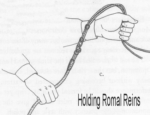

Horses are shown on a reasonable loose rein. Extremes such as too tight or too loose should be penalized.



Set-Up Options:
No Arena Fencing Required
Footing Required:
- Dirt
- Sand
- No grass base allowed
- No rock base allowed
Backboard or Natural Setting (Outdoor only; no Indoor setting allowed)
Examples of the Four Breed Divisions:
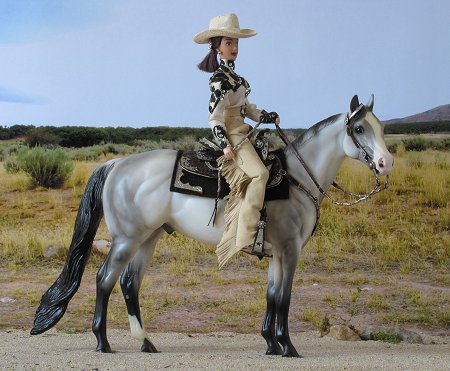
Western Pleasure Natural
Stock Breed Entry
Platinum Proof, shown as a QH stallion, is a Peter Stone Ideal Stock Horse, Cherish. Owned and shown by Andrea Robbins.
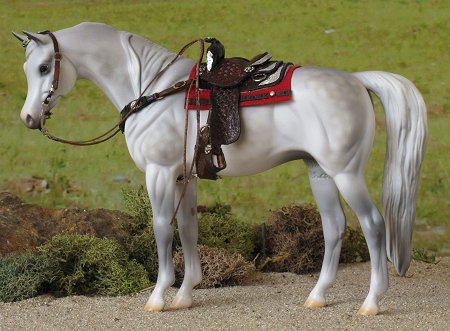
Western Pleasure Natural
Arabian Breed Entry
Sittin on a Cloud, is a Peter Stone Pebbles Arabian mare, Little Sure Shot. Owned and shown by Andrea Robbins. Note higher flexion at the poll even while standing still but horse is still on the bit and the nose is not sticking straight.

Western Pleasure Natural
TB/WB or Sporthorse Breed Entry
Wingman, shown as a palomino Thoroughbred gelding, is a Peter Stone TB, Midas. Owned and shown by Andrea Robbins.
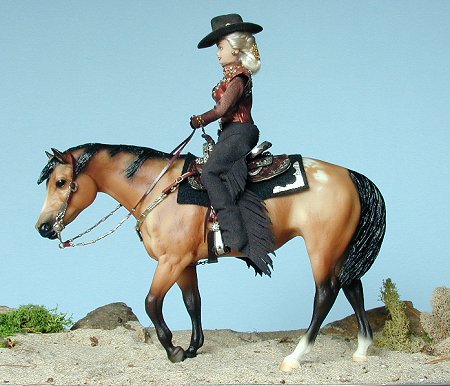
Western Pleasure Natural
Other Breed Entry
Goody Four Shoes, shown as an American Mustang, is a Breyer Indian Pony, Sheza Good Sport. Owned and shown by Andrea Robbins.
Hold the Reins Correctly:
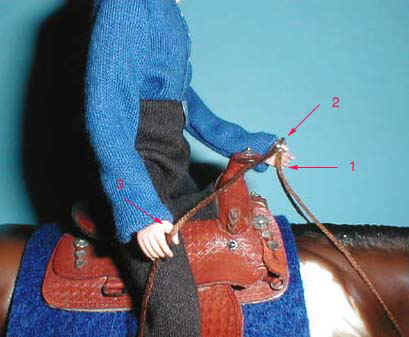
Romal Reins by Susan Hargrove
Romal reins enter the hand by the “little” finger lay across the palm of the hand and exit the hand on top over the thumb. The hand holds the reins and not the loop and knot that form the junction of the reins and the romal whip.
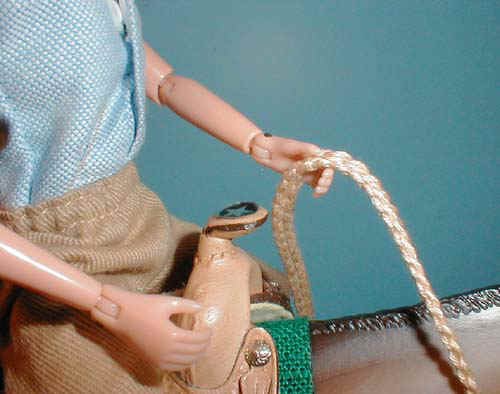
Split Reins by Susan Hargrove
Split reins can be held in the right or left hand. The excess rein hang over untouched on the same side of the horse. So if right hand hold the rein then the excess rein lies on the right side of the horse. If left hand holds the rein then the excess rein lies on the left side of the horse. Split reins enter the hand via coming straight into the hand over the index finger and they exit by the little finger.

Snaffle Reins by Susan Hargrove
The snaffle rein crosses over the horse’s neck with the bight extending down ward on the opposite side of the horse’s neck. Both hands are used on the reins by picking the rein and the bight up with the palms of the hands facing down.
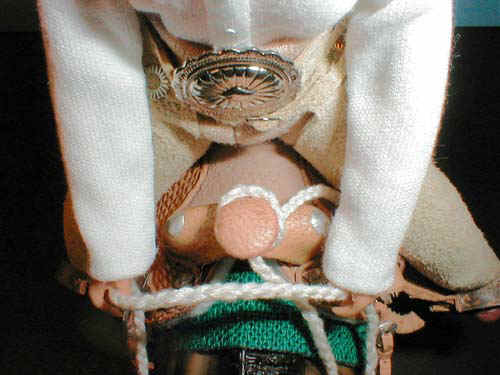
Hackamore Mecate Reins by Susan Hargrove
The hackamore mecate rein is a solid single loop rein with the bight tied from the bosal to either the saddle horn or coiled and tied to the front piggin string (or swell string) of the saddle. Both hands are used on the rein by picking the rein with the palms of the hands facing down.
